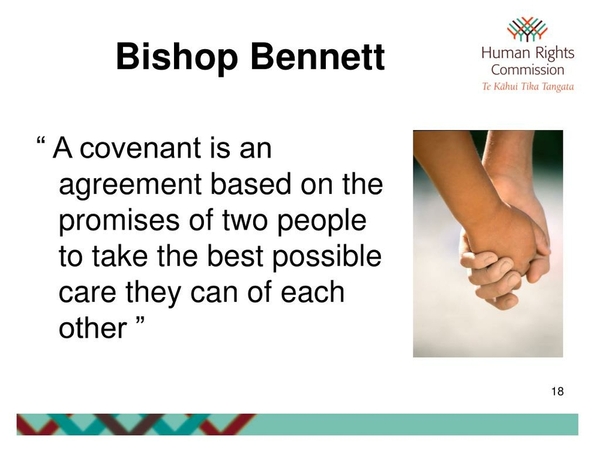New Zealand's Human Rights system is bound byTe Tiriti o Waitangi.
Te Tiriti o Waitangi was signed on 6 February 1840 by the Crown and Maori. It is legally binding and acknowledged internationally as a constitutional document.
Many do not know about He Whakaputanga o te Rangitiratanga o Nu Tireni, our Declaration of Independence which was signed five years earlier by more Maori on 28 October 1835.
He Whakaputanga o te Rangitiratanga o Nu Tirene is weaved into Te Tiriti o Waitangi and is therefore also legally binding.
Te Tiriti o Waitangi is the umbrella under which New Zealand's Human Rights Framework sits. It is therefore of great importance that people understand Te Tiriti o Waitangi.
This is my understanding of Te Tiriti o Waitangi as one Maori.
A quote from Bishop Bennett
Te Tiriti establishes standards for the Human Rights Framework and affirms the fundamental rights of all citizens of New Zealand
Te Tiriti establishes Turangawaewae for ALL citizens of New Zealand
Turangawaewae
A place for you to plant your feet
A place for you to belong
For ALL
Te Tiriti establishes that Maori are Tangata Whenua
Maori are Tangata Whenua
Maori have a spiritual connection to the whenua
Only Maori are Tangata Whenua
Te Tiriti has three principles:
- Partnership
- Participation
- Protection
To me, this means that I have the following rights:
- Right to be me
- Right to make decisions for me
- Right to participate in all things about me
- Right to the protection of ALL my human rights
We have a saying in NZ
In order to access those rights, we need to be informed in a meaningful way, in a way that we understand, so that we know when our rights are being violated and we can make decisions about things that are important to us.
Access to information
Access to participation
Access to the decision-making table
Are all things we must have
But many in NZ
DO NOT
Our New Zealand Human Rights Framework
"Sounds good but it is ineffective"
DANGER ZONES
The following are a few things that hold us back from ensuring ALL our people have access to our fundamental Human Rights here in New Zealand
- "Othering" ~ others make decisions for us as they "think" they know best
- "Don't know" ~ We are not provided with information and the information is inaccessible
- "Gatekeeping" ~ only a select few have access to information and are invited to the "decisionmaking table". Many are excluded, few are including. Those that are, tend to "other" us or they speak from their perspective and raise issues that "they" think are important for us ALL
- "Silence" ~ We suffer in silence rather than speak up. We do not ask for help. We do not know how to speak up or to ask for help. We can't speak up or ask for help.
- "Ceilings" ~ We tell ourselves that we can't do much. We are told we can't do much so we give up.
- "Labels" ~ We are given labels by others and then we believe that we are the label
- "Judgment" ~ We are often judged inaccurately by the way we look, by the way we talk, by our label. Those judgments made by others who have limited knowledge of the facts cause significant and long-lasting harm.
- Ceilings, labels, and inaccurate judgment work together to emotionally restrain and exclude us
- "Fear" ~ We are scared to reach out to find out our rights. We are scared to make complaints. We are scared of the unknown so we stay stuck with not knowing and with no options.
- "Uneducated" ~ We don't know much and we don't know how to get educated. We hate the education system. We can't read. We can't write. We don't want others to know we are uneducated.
- "Inaccessibility" ~ What we need is out of our reach. We can't access what we need because we can't, we don't know how to, we don't know it exists and others don't share it
SOLUTIONS
The solutions need a change in the way we think about ourselves and others.
We need to change our mindset.
Once we do, the solutions become easy
Here are a few things we could do:
- Build caring relationships with other
- Treat people with respect and dignity
- Allow people to speak for themselves
- Acknowledge and act on the voice of others ~ LISTEN and DO
- Share information freely
- Pull down barriers to access
- Include others
- Allow all to participate and acknowledge their contribution
- Allow people to sit at the decision-making table ~ make it bigger
- Create possibilities ~ the seemingly impossible is possible when we believe
- Provide a safe, caring environment to remove fear
- Be transparent
- Educate all
- Remove ceilings and labels
- Know me before you judge me
- Build connections and encourage networking
- Bring people together
- Provide protection for those who speak up and raise concerns
- Face the harm we have done to others, address it, and resolve it together
- Reach out
- Advocate for those who can't or don't know how to
- Empower others






Comments (2)